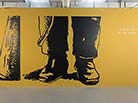Scuff Mark on an Eyelid — XXV Festival Ars Cameralis

Free entry. The exhibition will last till 15th January 2017.
Artists
Jean-Michel Alberola
François Boisrond
Edmund Clark
Damien Deroubaix
Sławomir Elsner
Joanna Helander & Bo Persson
Marek Kuś
Zbigniew Libera
Jean-Christophe Menu
Tony Oursler
Krzysztof Wodiczko

‘Scuff Mark on an Eyelid’ exhibition tour with the curator We kindly invite you to the guided tour with Marek Zieliński, the curator of the ‘Scuff Mark on an Eyelid’ exhibition, 21st December at 4 pm.

Scuff Mark on an Eyelid — a catalogue summary of the exibition “‘Scuff Mark on an Eyelid’ is about the ones who can no longer function according to the old rules because of the disturbing images that interfere with their...

On 4th October, in the Katowice BWA Contemporary Art Gallery there will be an opening of the exhibition entitled Scuff on an Eyelid, which has been inspired by the events of last year.
On 13th November 2015 most of the world heard the dramatic news from Paris about the explosions at the Stade de Paris, shootings at the restaurant terrace and café in the 11thdistrict, and about a violent attack on the audience who were listening to a concert at Batacan.
Since then, the list of locations touched by terrorist acts has expanded to include more cities and countries. Paris, Ankara, Bamako, Grand-Bassam, Brussels, Aleppo, Ouagadougou, Istanbul, Tunis and Nice — these are only few examples of many places that have suffered the tragic toll of dead and injured, followed by a procession of invisible human figures that have been traumatised by these vicious crimes. Fear is yet another weapon that attackers have at their disposal. It spreads turmoil and wreaks destruction worldwide, in various communities and individuals, undermining the foundations of our identity and way of life. This fear resembles a tsunami, spilling into each and every aspect of our lives. Also, it poses some fundamental questions about the meaning of life, society as community, as well as about the present and the future.
In an attempt to investigate the condition of humans in this ‘new world’, the French daily Le Monde encouraged a debate with the participation of many eminent members of the political, social and cultural milieus. Theirs answers had a very personal feel — some of them were full of anger, some expressed hope, others offered constructive suggestions or extremely utopian slogans. Amongst these many voices and opinions there was a contribution by Jean-Michel Alberola, a French artist who is taking part in the exhibition in Katowice (and who is the author of the exhibition poster). He believes that André Malraux’s famous words ‘Art is the only thing that resists death’, which was inspired by Gilles Deleuze’s cry for resistance in 1960 (which was his comment on the then dramatic events), are not really appropriate in the present circumstances. He says that today the right formula for everyday routine would be ‘reading, walking, listening, talking and watching — at all costs’. This seems to be a very radical approach, and a utopian one as well, as it refers to stoical philosophy, and especially to a special form of apathy, which for long centuries was supposed to be a remedy for the cruelty of the world. On the other hand, it might be a reference to the model whose visual symbol is Dürer’s Melancholia, with its appeal to suppress one’s emotions and maintain distance to everything around. Alberola also makes reference to Descartes’ ideas, which have been fundamental in building the perspective of the French nation, as well as to Kant’s aesthetics of sublimity. The artist points to another issue, which is important from the artistic viewpoint — terrorism is not only a political, but also a moral and aesthetic act! With art and the surrounding reality merging, artists need to come up with a new vision of the world, to create new aesthetics, and to find new ways in which these aesthetics could be expressed.
Today we are aware that art needs to show more than joy and sadness, which nicely fit into categories of Kant’s aesthetics, and which are exemplified by sunrises and sunsets; art also has to deal with violence and its aestheticized form. Decades before Descartes, Edmund Burke noticed that fear is one of the basic aesthetic values recognised by humans.
Curator: Marek Zieliński












